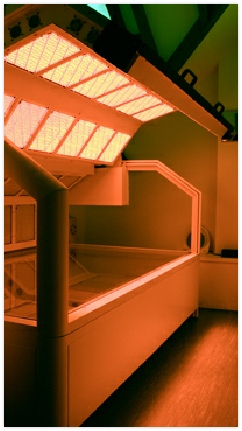





COPYRIGHT © ALL RIGHTS RESERVED. MADE BY DNJ
Search This Site for information
Photodynamic therapy is the use of light sensitive substances, which accumulate selectively in cancer cells and when exposed to light of an appropriate wavelength causes an excited state, that is able to transfer its energy to oxygen. This transfer of energy causes the electrons in oxygen to rearrange and assume a different electronic configuration, where all electrons in the oxygen molecule have paired up, resulting in a particular electron spin configuration. This is highly reactive and initiates a series of events that leads to the release of Cytochrome C from the mitochondria (these are the engines of the cell and are present in large numbers in all cells) and this initiates tumour cell death. Tumours tend to be hypoxic (lacking in oxygen), so in treatment protocols in some cases, ozone autohaemotherapy is also used, which is a method of increasing oxygen at the tumour site.


Sonodynamic Therapy is the use of low-level ultrasound that produces tumour destruction from the non-thermal effects of ultra sound, especially cavitations in malignant cells. Ultrasonic cavitations generate free radicals from the breakdown of water molecules. The Photodynamic agent used is also sensitive to ultrasound frequencies. This approach allows deeper penetration into the body. Sonodynamic therapy is carried out using a simple therapeutic ultrasound machine with an especially designed treatment head known as a maniple, which is applied over the affected area with some ultrasound gel placed on the skin. This is done after the light bed exposure; (see ‘A review of research into the uses of low level ultra sound in cancer therapy’, Uyu Wang & Mason in Ultra Sonics Sonochemistry, Vol 11, issue 2, April 2004, pages 95 — 130).
This uses light therapy followed by low-level ultrasound, which kills cancer cells using a non-thermal effect, especially cavitation. The agent used is sensitive to the ultrasound frequency of 3 Mhz. Following the light bed exposure (Photodynamic Therapy), the patient sits in a comfortable chair and the ultrasonic probe, covered with ultra sound gel, is moved over the skin on the area nearest to the main tumour mass. The use of ultrasound enables penetration significantly deeper into the body. (see a review of research into the uses of low level ultra sound in cancer therapy, Uyu, Wang & Mason in Ultra Sonics Sonochermistry, Vol 11, issue 2, April 2004, pages 95 — 130).
Most photosensitizers come from a class of naturally occurring compounds called porphorins. Natural porphorins are breakdown products from recycled haemoglobin and are inherently light sensitive. These accumulate in tumours and cause cancer cells to auto-fluoresce. The first generation of photosensitizers approved for use in cancer treatment - photofrin, - were derived from haemoglobin, whilst some of the more advanced agents are Chlorophyll derivatives.
PDT has several advantages over surgery and radiotherapy; it is comparatively non-invasive, it can be targeted accurately and repeated doses can be given without the total dose limitations associated with radiotherapy, and the healing process results in little or no scarring. PDT can always be done on an out-patient or day case setting, and it has no significant side effects.
Sonodynamic Photodynamic Therapy (SPDT) is a significant advance on PDT. This uses a specific agent which does not have to be given intravenously and can be given orally. It accumulates selectively in tumour sites and it does not persist in the skin, so no photosensitivity occurs. It is also a whole body treatment, and does not require the use of lasers. The agent is sensitised by a specialized light bed consisting of several tens of thousands of light emitting diodes, emitting in the red light region and the infra-red region of the spectrum. Because the breakdown wave lengths of the oral agent also occur in the infra-red region, this allows deeper penetration into the body, enabling tumours to be treated from the surface. Therefore, this is a non-invasive, whole body treatment. The treatment programme can be repeated as often as is necessary, and for advanced tumours it is best to treat slowly so as to avoid too rapid a tumour break down in too short a time.